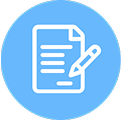Why does the email task matter? Strong emails help us in our daily work and study, and
they boost our scores. The PTE Email Task asks us to write a short email based on a
situation. In this guide, we cover what it is, skills tested, common prompts, steps,
smart tips, and quick FAQs for PTE Core students.
What is the PTE Email Task in PTE Core?
We write a short email based on a given situation and the reader. We pick the right tone, organize our thoughts, and cover each part. A good email follows a simple order that readers can scan. It starts with a greeting and a clear purpose. Then we add key details, request action, and sign off politely. We keep it concise, on point, and easy to read.
Task Format at a Glance
- The prompt gives a situation, goal, and reader.
- We choose a formal, semi-formal, or informal tone.
- We include greeting, body, closing, and name.
- We follow any word or content guidance in the prompt.
Skills Assessed in This Task
We gain points by staying relevant to the task, using the right tone, and staying organized. Clear paragraphs and logical flow help coherence. Correct grammar and sentence control raise clarity. Good vocabulary and accurate word choice show range. Clean spelling and punctuation keep the email professional. Together, these skills signal strong writing.
Tone and Audience Awareness
We match tone to who we are writing to and why. Use formal language for officials and managers. Keep it semi-formal for teachers and service staff. Use a warm, friendly tone with friends. Skip slang unless the request is clearly casual.
Grammar, Spelling, and Clarity
We write short sentences and use plain words. We fix subject-verb agreement and articles. We check the spelling of names, dates, places, and common email terms.

Types of Prompts in the PTE Email Task
Common prompt styles include giving information, making a request, complaining or giving feedback, apologizing, or thanking someone. The reader and purpose set the tone. Example ideas: share class schedule details, ask for a refund, report a service issue, say sorry for a missed meeting, thank a mentor for support.
Formal email prompts
We write to an office, company, school, or public service. Use polite phrases, a clear purpose, and a respectful sign-off.
Example idea: request a course change due to a schedule conflict.
Semi-formal email prompts
We write to a teacher, landlord, or team leader. Keep it polite but friendly.
Example idea: explain a maintenance issue and ask for a repair time.
Informal email prompts
We write to a friend or classmate. Use a friendly tone, simple words, and contractions.
Example idea: invite a friend to an event and share details.
We follow the prompt in order, keep the layout tidy, mirror key task words, write in short paragraphs, use active voice, skip jargon, and save a minute to proofread. This tight approach boosts clarity and helps readers act.
Write Email
In this task, you will see a text displayed on the screen. You are required to read the text aloud clearly and naturally. You will have 35 seconds to complete your reading, so focus on maintaining clarity, proper pronunciation, and a natural flow.
Sample Question 1:
Beginning in 10 sec
Sample Question 2:
Beginning in 10 sec
Sample Question 3:
Beginning in 10 sec
Try This Quick Outline:
- Open with the purpose.
- Add one or two brief detailed paragraphs.
- State a clear ask or next step.
- End with a courteous close.
- Keep the structure simple and clear:
Start with a greeting and a purpose line.
Add one or two short detail blocks.
Include the action or request.
Add a polite close, then a sign-off and name.
Use short, direct sentences.
Match tone and formality:
- Formal: Dear Sir or Madam. We are writing to request.
- Semi-formal: Dear Ms. Lee. We are writing about.
- This clean structure builds trust, saves time, and lifts response rates.
- Informal: Hi Sam, just a quick note to.
For extra practice, try these PTE Core Write Email Sample Questions.
- Plan and proofread fast.
- Plan before typing, then write, then check.
- Look for missing parts, tone errors, and easy grammar fixes.
- Correct any spelling mistakes or double spaces.
We can also review a ready-to-use template here: Best Template for PTE Write Email.

How to handle this task

Use a repeatable path every time.
Understand the question.
Highlight the key points.
Plan a quick outline.
Write a clean first draft.
Edit with purpose.
Keep it focused on the reader and the goal.
Aim for clarity and complete coverage of all prompts.
- Read and underline the goal.
- Mark the reader, purpose, and required points. Note the tone and any must include details.
- Plan with quick notes.
- Write a one-line purpose, list 2 to 3 key points, and choose a closing
- Draft, then revise
- Write the email using our plan, then fix tone, clarity, and errors. Make sure we answer every part.
Sample email:
Subject: Request to Replace Damaged Product
Dear Customer Support,
My recent order (Order ID: 12345) arrived damaged. I would like a replacement or a refund as soon as possible. Please let me know the next steps.
Thank you for your help.
Best regards,
John Doe
Learn more about other questions
Your Guide to Every Section of the PTE Exam
Speaking
Reading
FAQs
Here are answers to some of the frequently asked questions.
We can expect about three Email Writing tasks in the Writing section.
The suggested word count is 80 to 120 words.
Yes, but only for personal emails, such as notes to friends or family, if the prompt says so.
Yes. This task measures English writing skills, and mistakes can reduce the score.








